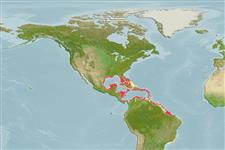Common names from other countries
>
Syngnathiformes (Pipefishes and seahorses) >
Syngnathidae (Pipefishes and seahorses) > Syngnathinae
Etymology: Hippocampus: Greek, ippos = horse + Greek,kampe = curvature (Ref. 45335).
More on author: Ginsburg.
Environment: milieu / climate zone / depth range / distribution range
Ecologie
marien; brak water rifbewoner; standvastig; diepte 0 - 60 m (Ref. 30915). Subtropical; 29°N - 25°S, 133°W - 40°W (Ref. 57010)
Western Atlantic: USA (North Carolina) to Brazil; the Caribbean Sea.
Lengte bij maturiteit / Grootte / Gewicht / Leeftijd
Maturity: Lm 8.0 range ? - ? cm
Max length : 17.5 cm OT mannelijk / geslacht onbekend; (Ref. 30915)
Dorsale stekels (totaal) : 0; Dorsale zachte stralen (totaal) : 16 - 19.
Uncommon in most areas, but may be locally common in certain places. Usually attached to gorgonians or seagrasses but may occur in floating Sargassum or swimming freely in midwater (Ref. 9710). Ovoviviparous (Ref. 205). The male carries the eggs in a brood pouch which is found under the tail (Ref. 205). Has been reared in captivity (Ref. 35409). Length type refers to Height (= from top of coronet to the tip of straightened tail). Maximum depth reported taken from Ref. 128812.
Breeding season more than 8 months in laboratory; egg diameter 1.2 mm; gestation period 2 weeks, depending on water temperature; young approximately 7 mm at birth; pair-bonded in wild (Ref. 30915). Monogamous mating is observed as both obligate and genetic (Ref. 52884).
Lourie, S.A., R.A. Pollom and S.J. Foster, 2016. A global revision of the seahorses Hippocampus Rafinesque 1810 (Actinopterygii: Syngnathiformes): taxonomy and biogeography with recommendations for further research. Zootaxa 4146(1):1-66. (Ref. 115213)
Status op de Rode Lijst van het IUCN (Ref. 130435)
Gevaar voor de mens
Harmless
Gebruik door de mens
Visserij: van minder commercieel belang
Tools
Speciale rapporten
Download XML
Internetbronnen
Estimates based on models
Preferred temperature (Ref.
115969): 24 - 28, mean 26.7 (based on 164 cells).
Fylogenetische diversiteitsindex (Ref.
82804): PD
50 = 0.5000 [Uniqueness, from 0.5 = low to 2.0 = high].
Bayesian length-weight: a=0.00447 (0.00177 - 0.01127), b=3.00 (2.78 - 3.22), in cm Total Length, based on LWR estimates for this (Sub)family-body shape (Ref.
93245).
Trofisch niveau (Ref.
69278): 3.4 ±0.5 se; based on size and trophs of closest relatives
Weerstandsvermogen (Ref.
120179): Gemiddeld, minimale populatieverdubbelingstijd 1,4-4,4 jaar (Assuming annual Fec<1000).
Fishing Vulnerability (Ref.
59153): Low vulnerability (12 of 100).
